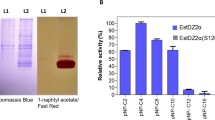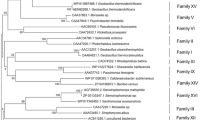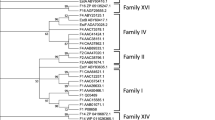Abstract
Two genes encoding esterases EstA and EstB of Picrophilus torridus were identified by the means of genome analysis and were subsequently cloned in Escherichia coli. PTO 0988, which is encoding EstA, consists of 579 bp, whereas PTO 1141, encoding EstB, is composed of 696 bp, corresponding to 192 aa and 231 aa, respectively. Sequence comparison revealed that both biocatalysts have low sequence identities (14 and 16%) compared to previously characterized enzymes. Detailed analysis suggests that EstA and EstB are the first esterases from thermoacidophiles not classified as members of the HSL family. Furthermore, the subunits with an apparent molecular mass of 22 and 27 kDa of the homotrimeric EstA and EstB, respectively, represent the smallest esterase subunits from thermophilic microorganisms reported to date. The recombinant esterases were purified by Ni2+ affinity chromatography, and the activity of the purified esterases was measured over a wide pH (pH 4.5–8.5) and temperature range (10–90°C). Highest activity of the esterases was measured at 70°C (EstA) and 55°C (EstB) with short pNP-esters as preferred substrates. In addition, esters of the non-steroidal anti-inflammatory drugs naproxen, ketoprofen, and ibuprofen are hydrolyzed by both EstA and EstB. Extreme thermostability was measured for both enzymes at temperatures as high as 90°C. The determined half-life (t 1/2) at 90°C was 21 and 10 h for EstA and EstB, respectively. Remarkable preservation of esterase activity in the presence of detergents, urea, and commonly used organic solvents complete the exceptional phenotype of EstA and EstB.






Similar content being viewed by others

References
Altschul SF, Lipman DJ (1990) Protein database searches for multiple alignments. Proc Natl Acad Sci USA 87:5509–5513
Altschul SF, Madden TL, Schaffer AA, Zhang J, Zhang Z, Miller W, Lipman DJ (1997) Gapped BLAST and PSI-BLAST: a new generation of protein database search programs. Nucleic Acids Res 25:3389–3402
Arpigny JL, Jaeger KE (1999) Bacterial lipolytic enzymes: classification and properties. Biochem J 343(Pt 1):177–183
Bates PA, Kelley LA, MacCallum RM, Sternberg MJ (2001) Enhancement of protein modeling by human intervention in applying the automatic programs 3D-JIGSAW and 3D-PSSM. Proteins Suppl 5:39–46
Bell PJ, Sunna A, Gibbs MD, Curach NC, Nevalainen H, Bergquist PL (2002) Prospecting for novel lipase genes using PCR. Microbiology 148:2283–2291
Bendtsen JD, Nielsen H, von Heijne G, Brunak S (2004) Improved prediction of signal peptides: SignalP 3.0. J Mol Biol 340:783–795
Bernstein HJ (2000) Recent changes to RasMol, recombining the variants. Trends Biochem Sci 25:453–455
Berriman M, Rutherford K (2003) Viewing and annotating sequence data with Artemis. Brief Bioinform 4:124–132
Bornscheuer UT (2002) Microbial carboxyl esterases: classification, properties and application in biocatalysis. FEMS Microbiol Rev 26:73–81
Bourdineaud JP, Nehme B, Tesse S, Lonvaud-Funel A (2003) The ftsH gene of the wine bacterium Oenococcus oeni is involved in protection against environmental stress. Appl Environ Microbiol 69:2512–2520
Bradford MM (1976) A rapid and sensitive method for the quantitation of microgram quantities of protein utilizing the principle of protein-dye binding. Anal Biochem 72:248–254
Britton HTS, Robinson RA (1931) Universal buffer solutions and the dissociation constant of veronal. J Chem Soc 458:1456–1462
Bull AT, Bunch AW, Robinson GK (1999) Biocatalysts for clean industrial products and processes. Curr Opin Microbiol 2:246–251
Carvalho PdO, Contesini FJ, Bizaco R, Calafatti SA, Macedo GA (2006) Optimization of enantioselective resolution of racemic ibuprofen by native lipase from Aspergillus niger. J Ind Microbiol Biotechnol 33:713–718
Chen YS, Lee GC, Shaw JF (2006) Gene cloning, expression, and biochemical characterization of a recombinant trehalose synthase from Picrophilus torridus in Escherichia coli. J Agric Food Chem 54:7098–7104
Ciaramella M, Napoli A, Rossi M (2005) Another extreme genome: how to live at pH 0. Trends Microbiol 13:49–51
De Simone G, Galdiero S, Manco G, Lang D, Rossi M, Pedone C (2000) A snapshot of a transition state analogue of a novel thermophilic esterase belonging to the subfamily of mammalian hormone-sensitive lipase. J Mol Biol 303:761–771
Demirjian DC, Moris-Varas F, Cassidy CS (2001) Enzymes from extremophiles. Curr Opin Chem Biol 5:144–151
Dharmsthiti S, Pratuangdejkul J, Theeragool GT, Luchai S (1998) Lipase activity and gene cloning of Acinetobacter calcoaceticus LP009. J Gen Appl Microbiol 44:139–145
Di Giulio M (2005) Structuring of the genetic code took place at acidic pH. J Theor Biol 237:219–226
Dutta S, Berman HM (2005) Large macromolecular complexes in the Protein Data Bank: a status report. Structure 13:381–388
Ejima K, Liu J, Oshima Y, Hirooka K, Shimanuki S, Yokota Y, Hemmi H, Nakayama T, Nishino T (2004) Molecular cloning and characterization of a thermostable carboxylesterase from an archaeon, Sulfolobus shibatae DSM5389: non-linear kinetic behavior of a hormone-sensitive lipase family enzyme. J Biosci Bioeng 98:445–451
Finn RD, Mistry J, Schuster-Bockler B, Griffiths-Jones S, Hollich V, Lassmann T, Moxon S, Marshall M, Khanna A, Durbin R et al (2006) Pfam: clans, web tools and services. Nucleic Acids Res 34:D247–D251
Fischer M, Thai QK, Grieb M, Pleiss J (2006) DWARF—a data warehouse system for analyzing protein families. BMC Bioinformatics 7:495
Futterer O, Angelov A, Liesegang H, Gottschalk G, Schleper C, Schepers B, Dock C, Antranikian G, Liebl W (2004) Genome sequence of Picrophilus torridus and its implications for life around pH 0. Proc Natl Acad Sci USA 101:9091–9096
Gasteiger E, Gattiker A, Hoogland C, Ivanyi I, Appel RD, Bairoch A (2003) ExPASy: The proteomics server for in-depth protein knowledge and analysis. Nucleic Acids Res 31:3784–3788
GOLD (2006) The Genomes On Line Database. Available at http://www.genomesonline.org. Accessed October 11 2006
Golyshina OV, Golyshin PN, Timmis KN, Ferrer M (2006) The ‘pH optimum anomaly’ of intracellular enzymes of Ferroplasma acidiphilum . Environ Microbiol 8:416–425
Hotelier T, Renault L, Cousin X, Negre V, Marchot P, Chatonnet A (2004) ESTHER, the database of the alpha/beta-hydrolase fold superfamily of proteins. Nucleic Acids Res 32:D145–D147
Hotta Y, Ezaki S, Atomi H, Imanaka T (2002) Extremely stable and versatile carboxylesterase from a hyperthermophilic archaeon. Appl Environ Microbiol 68:3925–3931
Huddleston S, Yallop CA, Charalambous BM (1995) The identification and partial characterisation of a novel inducible extracellular thermostable esterase from the archaeon Sulfolobus shibatae. Biochem Biophys Res Commun 216:495–500
Jaeger KE, Ransac S, Dijkstra BW, Colson C, van Heuvel M, Misset O (1994) Bacterial lipases. FEMS Microbiol Rev 15:29–63
Jaeger KE, Dijkstra BW, Reetz MT (1999) Bacterial biocatalysts: molecular biology, three-dimensional structures, and biotechnological applications of lipases. Annu Rev Microbiol 53:315–351
Kim S, Lee SB (2004) Thermostable esterase from a thermoacidophilic archaeon: purification and characterization for enzymatic resolution of a chiral compound. Biosci Biotechnol Biochem 68:2289–2298
Laemmli UK (1970) Cleavage of structural proteins during the assembly of the head of bacteriophage T4. Nature 227:680–685
Manco G, Di Gennaro S, De Rosa M, Rossi M (1994) Purification and characterization of a thermostable carboxylesterase from the thermoacidophilic eubacterium Bacillus acidocaldarius. Eur J Biochem 221:965–972
Manco G, Adinolfi E, Pisani FM, Ottolina G, Carrea G, Rossi M (1998) Overexpression and properties of a new thermophilic and thermostable esterase from Bacillus acidocaldarius with sequence similarity to hormone-sensitive lipase subfamily. Biochem J 332(Pt 1):203–212
Manco G, Camardella L, Febbraio F, Adamo G, Carratore V, Rossi M (2000) Homology modeling and identification of serine 160 as nucleophile of the active site in a thermostable carboxylesterase from the archaeon Archaeoglobus fulgidus. Protein Eng 13:197–200
Mandrich L, Pezzullo M, Rossi M, Manco G (2006) SSoNΔ and SSoNΔlong: two thermostable esterases from the same ORF in the archaeon Sulfolobus solfataricus? Archaea 2:1–7
Margolin AL (1993) Enzymes in the synthesis of chiral drugs. Enzyme Microb Technol 15:266–280
Morana A, Di Prizito N, Aurilia V, Rossi M, Cannio R (2002) A carboxylesterase from the hyperthermophilic archaeon Sulfolobus solfataricus: cloning of the gene, characterization of the protein. Gene 283:107–115
Morel F, Delmas F, Jobin MP, Divies C, Guzzo J (2001) Improved acid tolerance of a recombinant strain of Escherichia coli expressing genes from the acidophilic bacterium Oenococcus oeni. Lett Appl Microbiol 33:126–130
Park YJ, Choi SY, Lee HB (2006) A carboxylesterase from the thermoacidophilic archaeon Sulfolobus solfataricus P1; purification, characterization, and expression. Biochim Biophys Acta 1760:820–828
Rhee JK, Ahn DG, Kim YG, Oh JW (2005) New thermophilic and thermostable esterase with sequence similarity to the hormone-sensitive lipase family, cloned from a metagenomic library. Appl Environ Microbiol 71:817–825
Sambrook J, Fritsch EF, Maniatis T (1989) Molecular cloning: a laboratory manual, 2nd edn. Cold Spring Harbor Laboratory Press, Cold Spring Harbor
Sanger F, Nicklen S, Coulson AR (1977) DNA sequencing with chain-terminating inhibitors. Proc Natl Acad Sci USA 74:5463–5467
Sayle RA, Milner-White EJ (1995) RASMOL: biomolecular graphics for all. Trends Biochem Sci 20:374
Schepers B, Thiemann V, Antranikian G (2006) Characterization of a novel glucoamylase from the thermoacidophilic Archaeon Picrophilus torridus heterologously expressed in E. coli. Eng Life Sci 6:311–317
Schmidt-Dannert C, Sztajer H, Stocklein W, Menge U, Schmid RD (1994) Screening, purification and properties of a thermophilic lipase from Bacillus thermocatenulatus. Biochim Biophys Acta 1214:43–53
Schomburg I, Chang A, Ebeling C, Gremse M, Heldt C, Huhn G, Schomburg D (2004) BRENDA, the enzyme database: updates and major new developments. Nucleic Acids Res 32:D431–D433
Schutte M, Fetzner S (2007) EstA from Arthrobacter nitroguajacolicus Ru61a, a thermo- and solvent-tolerant carboxylesterase related to Class C beta-lactamases. Curr Microbiol
Serour E, Antranikian G (2002) Novel thermoactive glucoamylases from the thermoacidophilic Archaea Thermoplasma acidophilum, Picrophilus torridus and Picrophilus oshimae . Antonie Van Leeuwenhoek 81:73–83
Sobek H, Gorisch H (1988) Purification and characterization of a heat-stable esterase from the thermoacidophilic archaebacterium Sulfolobus acidocaldarius. Biochem J 250:453–458
Suzuki Y, Miyamoto K, Ohta H (2004) A novel thermostable esterase from the thermoacidophilic archaeon Sulfolobus tokodaii strain 7. FEMS Microbiol Lett 236:97–102
Thompson JD, Higgins DG, Gibson TJ (1994) CLUSTAL W: improving the sensitivity of progressive multiple sequence alignment through sequence weighting, position-specific gap penalties and weight matrix choice. Nucleic Acids Res 22:4673–4680
Thompson JD, Gibson TJ, Plewniak F, Jeanmougin F, Higgins DG (1997) The CLUSTAL_X windows interface: flexible strategies for multiple sequence alignment aided by quality analysis tools. Nucleic Acids Res 25:4876–4882
Vossenberg vd, Driessen AJ, Zillig W, Konings WN (1998) Bioenergetics and cytoplasmic membrane stability of the extremely acidophilic, thermophilic archaeon Picrophilus oshimae. Extremophiles 2:67–74
Winkler UK, Stuckmann M (1979) Glycogen, hyaluronate, and some other polysaccharides greatly enhance the formation of exolipase by Serratia marcescens. J Bacteriol 138:663–670
Acknowledgments
This work was supported by grant 04-008 202131 from the German BMBF. We would like to thank Dr. Maryna Royter and Dr. Christian Elend for their support.
Author information
Authors and Affiliations
Corresponding author
Additional information
Communicated by K. Horikoshi.
Rights and permissions
About this article
Cite this article
Hess, M., Katzer, M. & Antranikian, G. Extremely thermostable esterases from the thermoacidophilic euryarchaeon Picrophilus torridus . Extremophiles 12, 351–364 (2008). https://doi.org/10.1007/s00792-008-0139-9
Received:
Accepted:
Published:
Issue Date:
DOI: https://doi.org/10.1007/s00792-008-0139-9



